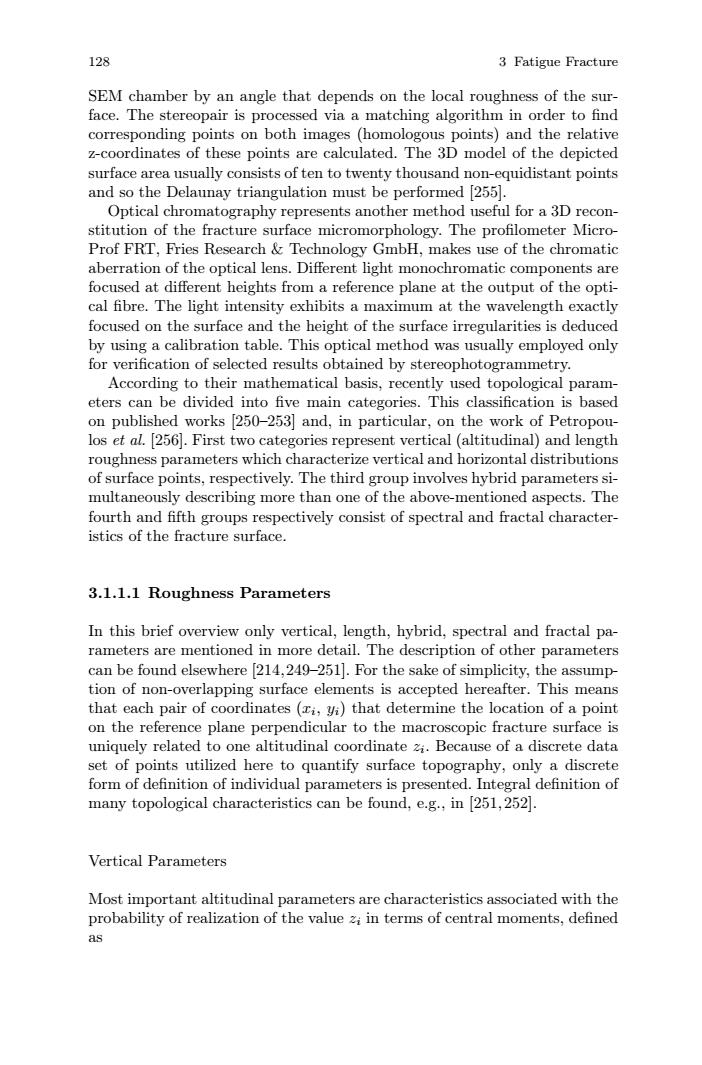正在加载图片...

128 3 Fatigue Fracture SEM chamber by an angle that depends on the local roughness of the sur- face.The stereopair is processed via a matching algorithm in order to find corresponding points on both images (homologous points)and the relative z-coordinates of these points are calculated.The 3D model of the depicted surface area usually consists of ten to twenty thousand non-equidistant points and so the Delaunay triangulation must be performed [255. Optical chromatography represents another method useful for a 3D recon- stitution of the fracture surface micromorphology.The profilometer Micro- Prof FRT,Fries Research Technology GmbH,makes use of the chromatic aberration of the optical lens.Different light monochromatic components are focused at different heights from a reference plane at the output of the opti- cal fibre.The light intensity exhibits a maximum at the wavelength exactly focused on the surface and the height of the surface irregularities is deduced by using a calibration table.This optical method was usually employed only for verification of selected results obtained by stereophotogrammetry. According to their mathematical basis,recently used topological param- eters can be divided into five main categories.This classification is based on published works 250-253]and,in particular,on the work of Petropou- los et al.[256].First two categories represent vertical (altitudinal)and length roughness parameters which characterize vertical and horizontal distributions of surface points,respectively.The third group involves hybrid parameters si- multaneously describing more than one of the above-mentioned aspects.The fourth and fifth groups respectively consist of spectral and fractal character- istics of the fracture surface. 3.1.1.1 Roughness Parameters In this brief overview only vertical,length,hybrid,spectral and fractal pa- rameters are mentioned in more detail.The description of other parameters can be found elsewhere [214,249-251.For the sake of simplicity,the assump- tion of non-overlapping surface elements is accepted hereafter.This means that each pair of coordinates(ri,yi)that determine the location of a point on the reference plane perpendicular to the macroscopic fracture surface is uniquely related to one altitudinal coordinate zi.Because of a discrete data set of points utilized here to quantify surface topography,only a discrete form of definition of individual parameters is presented.Integral definition of many topological characteristics can be found,e.g.,in [251,252] Vertical Parameters Most important altitudinal parameters are characteristics associated with the probability of realization of the value zi in terms of central moments,defined as128 3 Fatigue Fracture SEM chamber by an angle that depends on the local roughness of the surface. The stereopair is processed via a matching algorithm in order to find corresponding points on both images (homologous points) and the relative z-coordinates of these points are calculated. The 3D model of the depicted surface area usually consists of ten to twenty thousand non-equidistant points and so the Delaunay triangulation must be performed [255]. Optical chromatography represents another method useful for a 3D reconstitution of the fracture surface micromorphology. The profilometer MicroProf FRT, Fries Research & Technology GmbH, makes use of the chromatic aberration of the optical lens. Different light monochromatic components are focused at different heights from a reference plane at the output of the optical fibre. The light intensity exhibits a maximum at the wavelength exactly focused on the surface and the height of the surface irregularities is deduced by using a calibration table. This optical method was usually employed only for verification of selected results obtained by stereophotogrammetry. According to their mathematical basis, recently used topological parameters can be divided into five main categories. This classification is based on published works [250–253] and, in particular, on the work of Petropoulos et al. [256]. First two categories represent vertical (altitudinal) and length roughness parameters which characterize vertical and horizontal distributions of surface points, respectively. The third group involves hybrid parameters simultaneously describing more than one of the above-mentioned aspects. The fourth and fifth groups respectively consist of spectral and fractal characteristics of the fracture surface. 3.1.1.1 Roughness Parameters In this brief overview only vertical, length, hybrid, spectral and fractal parameters are mentioned in more detail. The description of other parameters can be found elsewhere [214,249–251]. For the sake of simplicity, the assumption of non-overlapping surface elements is accepted hereafter. This means that each pair of coordinates (xi, yi) that determine the location of a point on the reference plane perpendicular to the macroscopic fracture surface is uniquely related to one altitudinal coordinate zi. Because of a discrete data set of points utilized here to quantify surface topography, only a discrete form of definition of individual parameters is presented. Integral definition of many topological characteristics can be found, e.g., in [251, 252]. Vertical Parameters Most important altitudinal parameters are characteristics associated with the probability of realization of the value zi in terms of central moments, defined as